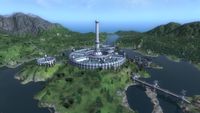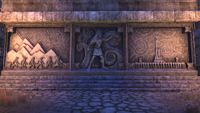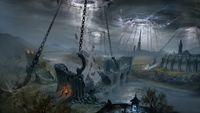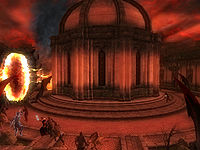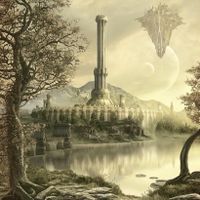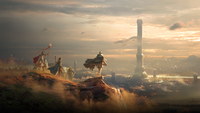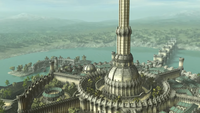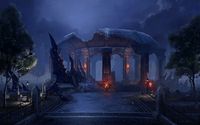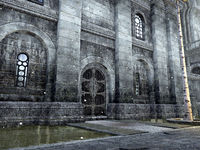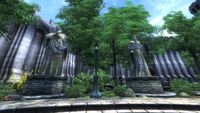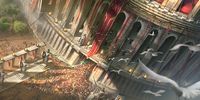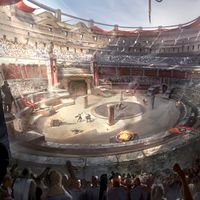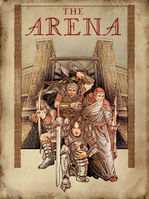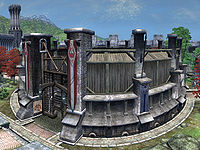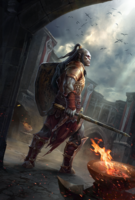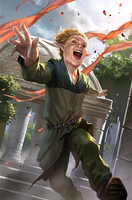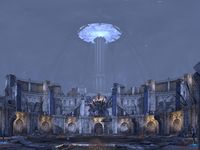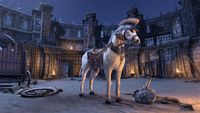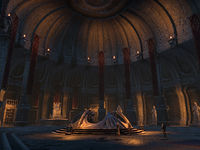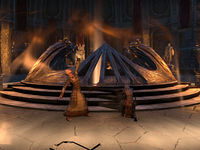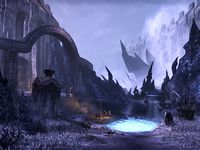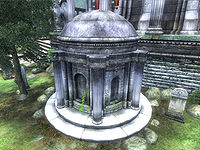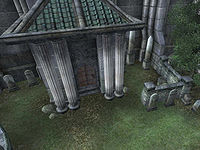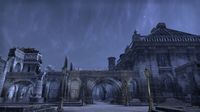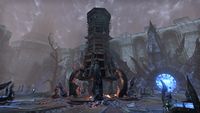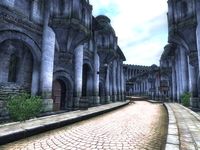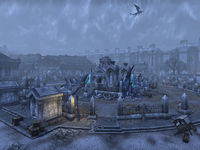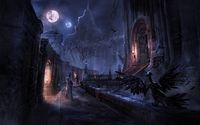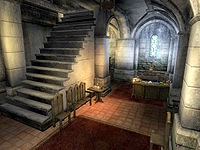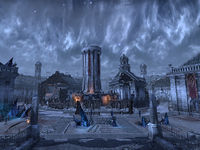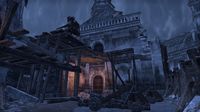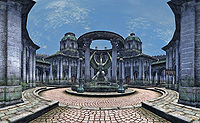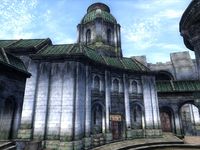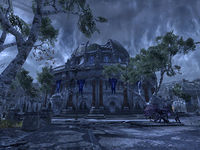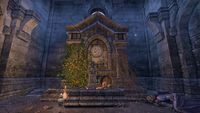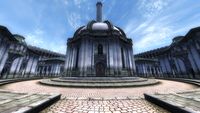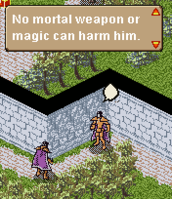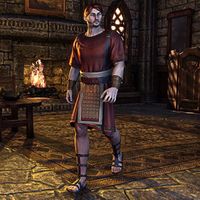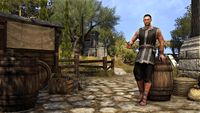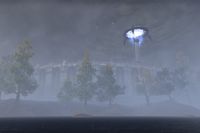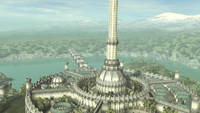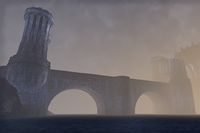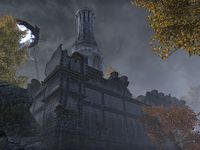Lore:Imperial City
| To meet our site's higher standard of quality, this article or section may require cleanup. The user who placed this here had the following concern: Unfinished To leave a message about the cleanup for this article, please add it to this article's talk page. |
| Imperial City | |
|---|---|
| Type | Settlement |
| Continent | Tamriel |
| Province | Cyrodiil |
| Region | Heartlands (City Isle) |
| Appears in | Arena, Oblivion, Oblivion Mobile, The Infernal City, Lord of Souls, ESO, Legends, Blades |
- "There is but one city in the Imperial Province, but one city in Tamriel, but one city in the World; that, my brothers, is the city of the Cyrodiils." –Refayj [1]
The Imperial City (also known as Cyrodiil,[2] Cyrodiil City,[3] the Imperial Capital, the Capital, and the City of a Thousand Cults[4]) is the capital city of Cyrodiil Province and the Tamrielic Empire, the city belongs to a political territory known as the Imperium[5][6] or County Imperium.[UOL 1] Culturally Nibenese, the Imperial City is described as the heart of Tamriel.
A thriving city, its flooded lower dwellings are sailed by gondolas and riverboats. Moth Priests walk the streets in clouds of ancestor moths. House guards bearing exceptionally long daikatanas keep watch over the streets. The city proper is located on City Isle, which lies in the center of Lake Rumare, but continues across the lake and merges into ruins left by the Interregnum and the villages of the southern Niben River. The city stains the mouth of the Niben red with the tinmi soil of Rumare's shores.[1]
History[edit]
Merethic Era And First Era[edit]
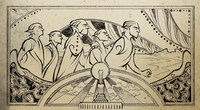
Before the founding of the city, when Beastfolk dominated Tamriel, the native Bird Men lived on the eight islands. In the middle Merethic era Topal the Pilot, in search of Aldmeris, came upon the islands and the native Bird Men. Topal lived among them for some time and, in exchange for the secrets of literacy, was gifted the eight islands for the Aldmer.[7][8] The history of the Imperial City itself began with the construction of the White-Gold Tower by the earliest Aldmeri migrants to Cyrodiil in the middle Merethic Era and was the center of the region occupied by their Ayleid descendants. The tower was originally called the Temple of the Ancestors, and was home to the Ten Ancestors, a set of Ayleid statues made from meteoric iron and glass.[9] By 1E 0, due to the long lines of communication between the high kings in the Crystal Tower and the tributary kings in White-Gold, the latter had become an independent state.[10]
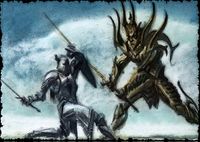
In 1E 243, one year into the Alessian Slave Rebellion, the Alessian forces advanced on the city. During the siege, the Ten Ancestors were removed from the City and dispersed among other Ayleid cities.[9] Once Pelinal breached the White-Gold Tower, the Ayleid king Umaril the Unfeathered challenged him to a duel. Outraged by the hesitation of the other rebel leaders to assault the Tower, Pelinal confronted Umaril alone. Though wounded by the Ayleid king, he prevailed, but was immediately killed and cut into eight pieces by the other Ayleid kings. The next morning Morihaus shook the White-Gold Tower by smashing into it; the humans of the rebellion had finally claimed the City for Alessia.[11] While official histories of the First Empire state that when Alessia's forces captured the Tower, all the Ayleids' relics of arcane power were taken and destroyed, others insisted that a king had escaped with the chief artifacts.[12]
On the 23rd of Sun's Dawn 1E 461, Emperor Gorieus was crowned in the Imperial City without any entertainment in accordance with Marukh's doctrine.[13]
In 1E 478, the Imperial City survived a plague that swept the Colovian West unscathed and killed King Mhorus Larich of Skingrad, which led his eldest surviving son Dorald, an Alessian priest in the Imperial City, to immediately cede the kingdom to the Empire.[13]
In 1E 946, construction of the Imperial Arena began under Gaiden Shinji.[14]
According to the Remanada, Reman was then found at Sancre Tor with the Amulet of Kings embedded in his forehead by a shepherdess who carried the infant to the White-Gold Tower and placed him on the throne uncontested at an unknown date in the First Era.[15]
Imperial painters resumed painting the Imperial City in its entirety late into the thirtieth century of the First Era, after severe Alessian restrictions on artists which grew into cultural taboos fell.[16]
Throughout 1E 2920, the Imperial City saw many great events. On the 19th of Mid Year the Potentate arrived in the Imperial City amid great fanfare, the streets lined with men and women cheering him as the symbol of the taking of Ald Marak. During Sun's Dusk, preparations were made for the arrival of Vivec in the Imperial Palace, an event attended by prominent nobles such as King Dro'Zel of Senchal. The audience chamber of the Palace dangled silver ribbons from the rafters, burning cauldrons of sweet herbs simmered in every corner, and Pyandonean swallowtails swept through the air, singing their songs. On the 6th of Evening Star Emperor Reman III was assassinated by the Morag Tong on behalf of Versidue-Shaie on his own throne. On the 22nd of Evening Star Versidue-Shaie announced from the Speaker's Balcony of the Imperial Palace that the Cyrodiil line was dead and that he would assume the role of Emperor but keep the title of Potentate, with his first act being the declaration of the beginning of the Second Era.[17]
Second Era[edit]
In 2E 400, Potentate Savirien-Chorak held a celebration to commemorate four centuries of potentate rule. Festivities in the Imperial City included many games, revelries and a poetry competition.[18]
Longhouse Emperors[edit]
Sometime before 2E 541, the Reachman warlord Durcorach the Black Drake conquered the Imperial City, and was proclaimed Emperor of Cyrodiil shortly after. Durcorach married Veraxia Tharn to legitimize his rule, and the so-called Longhouse Emperors would go on to rule over the Imperial City and Cyrodiil longer than most previous conquerors.[19] His son, Emperor Moricar the Middling, preferred to stay in the Imperial City rather than accompanying his armies.[20] After his own son, Prince Leovic, returned from his campaign against border raiders, he was received in the Great Hall of White-Gold, where he chose Clivia Tharn as his wife;[21] he had inherited the Ruby Throne by 2E 566.[22]
Varen's Rebellion and the Soulburst[edit]
Varen's Rebellion ended in 2E 577 when Varen Aquilarios's forces stormed the Imperial City and confronted Leovic's last legion in a bloody battle that razed the Market District. Varen personally dispatched Leovic at the foot of the Ruby Throne before proclaiming himself emperor.[23]
The Soulburst of 2E 578 (or 2E 579) was a massive explosion of arcane energy which sundered the veil between Nirn and Oblivion, and disrupted the connection between the souls of the denizens of Nirn and their mortal hosts. The Elder Scrolls themselves named this event after it was set into motion.
The necromancer Mannimarco had convinced the Cyrodilic Emperor Varen Aquilarios that, despite not being Dragonborn, as all true emperors must be, if they slightly modified the coronation ritual, they would be able to both relight the Dragonfires and convince Akatosh to gift Varen with the blood of a dragon. However, Mannimarco had corrupted the coronation ritual of the Amulet of Kings, having spent weeks inscribing glyphs and incantantions that would weaken the ancient barriers protecting Nirn and tear the veil between worlds , setting the mortal realm adrift in Oblivion. Thus by performing the ritual, Varen broke the divine covenant of Akatosh and Alessia which protected Nirn from the forces of Oblivion.
As the veil between worlds shattered, a wave of magical energy radiated outwards from the Imperial City, and Emperor Aquilarios was lost in the explosion. Mystical aftershocks propagated all across the planet. Mages died or went mad, Red Mountain trembled, earthquakes shook Skyrim, heavy storms devastated the coastlines of Elsweyr and Valenwood, and Nirn came "unmoored from the fabric of the multiverse". The event caused numerous mages in the vicinity of Imperial City to die or go mad while mages in the Heartlands suffered injuries. Chorrol was significantly affected when earthquakes ruptured the ground in a cataclysm dubbed by locals as the "Sundering", splitting the town and leaving a gaping fissure infested with flame atronachs that killed a number of the town's civilians. Wooden walkways were erected over the chasm but the noxious fumes caused many to fall to their deaths while crossing. The event was sensed by the magically sensitive across Tamriel, and the constellation of the Serpent grew so large it dominated the night sky and seemed to threaten every other star sign at once. Nirn became vulnerable to the forces of Oblivion, and Daedra began appearing in greater numbers than ever before. Molag Bal, the Daedric Prince of Domination and Mannimarco's master, seized the opportunity to begin disconnecting the souls of Nirn from their hosts to fuel the Planemeld, an attempt to merge his realm of Coldharbour with Nirn. The Soulburst also frayed the veil between Mundus and Aetherius, causing a rise in the number of ghosts, revenants, and wraiths across Tamriel which became audible and visible to even average mortals. The weakening of the veil also made it easier for necromancers to raise corpses on an unprecedented scale.
At some point after the Soulburst, mysterious slate-skinned figures, known as Red Diamond Guardians, periodically appeared in the Imperial City to fight the Daedra. Each one had the Red Diamond encrusted upon their torso. No one knew where they came from or where they went after each fray.
The Imperial City Mages Guild was blamed for the explosion and expelled from the city by the Elder Council, with control of the Arcane University given over to the "Fellowship of Anchorites" (a pseudonym for Mannimarco's Worm Cult).
Planemeld and Planemeld Obverse[edit]
During the Planemeld, the Imperial City was invaded by the Daedric forces of Molag Bal, who were helped by the Worm Cult and the traitorous Legion Zero. Dark Anchors opened above the city, from which Daedra flooded out, killing and enslaving the citizens of the City. A giant Dark Anchor was then opened above the White-Gold Tower. The Daggerfall Covenant, Ebonheart Pact, and Aldmeri Dominion invaded the City and extensively fought among themselves and against the legions of Daedra and Worm Cultists during the Three Banners War, in an effort to claim the Imperial City for themselves.[24]
In a final attempt to restart the Planemeld,[UOL 2] Bal sent a Xivkyn called Molag Kena to pose as the seemingly-deceased Empress Regent Clivia Tharn and "retake" the White-Gold Tower. In truth, Kena sought an Elder Scroll within the Tower and planned to use its power to initiate the "Planemeld Obverse" and begin simultaneously pulling Coldharbour into Tamriel. However, a moth priestess called Terran Arminus had read the scroll before the Daedric occupation of the Imperial City, and had learned that she would need aid in order to save the scroll. This aid arrived in the form of a group of Undaunted, and the prophesied Soulless One, who helped Clivia's entourage ascend the shattered reality of the Tower's upper levels before being betrayed by the imposter. These heroes defeated Molag Kena atop the Tower before she could fully complete the ritual, and in the process destroyed the Anchor above the city.[25][26]
Coinciding with the events at White-Gold Tower, Bal's forces began to search the city for a relic called the Sublime Brazier. Housed in the hidden Dragonfire Cathedral in the Ayleid ruins beneath the city, this brazier was key to relighting the Dragonfires.[27] If it was destroyed, Akatosh's Covenant would be broken and Mundus would be eternally vulnerable to Daedric invasion. This plot was uncovered by the Drake of Blades, a mysterious Dragonguard agent still operating within the city. With the help of the Vestige and other allies, the Drake entered Dragonfire Cathedral and performed a ritual to become the brazier's immortal guardian. The Daedric siege of the cathedral was lifted in the process, and the leader of Bal's forces, Xivkyn General Malivus, was banished.[28] The Drake would serve as guardian for all time, effectively foiling Molag Bal's plot.
Tiber War[edit]
Cuhlecain captured the Imperial City in 2E 854. Before he was crowned, however, he was assassinated, and Zurin Arctus then crowned Tiber Septim the new Emperor of all Cyrodiil.[29]
In 2E 857, the Cult of the Ancestor Moth rose up in the Moth Rebellion. The Third Legion, mostly comprised of newly-recruited Colovian peasant boys, was sent from nearby Anvil to quell it. There the Legion earned its sobriquet "The Faithful" while besieged in the Hesod Barracks by the Cultists. After the rebellion ended, Tiber Septim triumphantly reentered the capital.[30]
Third Era[edit]
Destri Melarg, famed Redguard historian and translator began his study and writings in the Imperial City in 3E 39, where he took the last name of Melarg due to the Breton, Nordic, and Dark Elf cultures he encountered in the City.[31]
Under Antiochus, the city was as infamously decadent as its Emperor. The result of this was the War of the Red Diamond, in which the Imperial City was captured in only a fortnight by Uriel Septim III in 3E 121 as two other attacks drew Imperial forces away from the capital.[32]
Circa 3E 145 - 3E 153, the Mad Emperor Pelagius Septim III had the Imperial Palace undergo frequent early-morning scrubdowns due to his obsession with cleanliness.[33]
Imperial Simulacrum[edit]
In 3E 391, Queen Barenziah accompanied her daughter and son on a journey to the Imperial City. Barenziah was there to plead with the emperor for aid, and hoped the presence of the children would soften his heart. However the false emperor remained unmoved, and when word came that evening that her husband Symmachus was killed in a revolt, the surviving royals were forced into exile.[34]
Circa 3E 397, a shadowmage named Skelos Undriel was driven from the Imperial City by Tharn's agents, and Undriel fled to the Western Reach, a region at the time engulfed in the War of the Bend'r-mahk.[35][36]
In 3E 399, the Eternal Champion entered the Imperial City and descended into the depths of the Imperial Palace to face the imposter Jagar Tharn. Tharn was killed by the Champion, which freed Uriel Septim VII and General Warhaft, putting an end to the Imperial Simulacrum.[37] Following the Restoration, a grand state memorial service was held for Symmachus at the Imperial City, befitting the man who had served the Septim Dynasty for so long and so well.[34]
Even years after the Imperial Simulacrum, the people were paranoid and unrest developed in the Imperial City. Wizards claimed that the Emperor's Sons; Geldall, Ebel, and Enman were actually doppelgangers placed in the Imperial Palace by Jagar Tharn from when he was still the Imperial Battlemage. A mob developed calling for the death of these "false" heirs and Imperial Guard retaliated. Many people died in the ensuing conflict.[38] The unrest became so drastic that members of the Imperial Legion in Morrowind believed they would be recalled to protect the Emperor.[39]
Oblivion Crisis[edit]
The Oblivion Crisis began and ended in the Imperial City during 3E 433, with the assassination of Uriel Septim VII by the Mythic Dawn. Before he died, Septim gave the Amulet of Kings to a prisoner who had accompanied him and his Blades.[40] The prisoner then fled through the Imperial Prison's sewer system to Weynon Priory.[41] After the Defense of Bruma and the death of Mankar Camoran, the Hero of Kvatch and Martin Septim rushed to the Imperial City to meet High Chancellor Ocato. Just as Ocato accepted Martin's claim to the throne they were alerted that Oblivion gates had begun to open all over the City. High Chancellor Ocato, Martin Septim, his Blades and Imperial Legionary escorts fought their way through a besieged Imperial City. The Daedric Prince Mehrunes Dagon himself appeared in the city, marking the fall of the barriers between Oblivion and Nirn. The battle ended when Martin Septim, in a desperate last-ditch effort to light the Dragonfires, shattered the Amulet of Kings and became the Avatar of Akatosh. The Avatar banished Dagon back to Oblivion, ending the Crisis. The Avatar turned to stone, killing Martin, but also leaving a permanent reminder of his sacrifice in the form of a statue.[42]
Fourth Era[edit]
In 4E 17, Titus Mede captured the Imperial City with a thousand men and seized control of the Empire from Thules the Gibbering, marking the start of the Mede Dynasty.
Umbriel Crisis[edit]
Umbriel invaded Tamriel in 4E 48, first appearing far off the coast of Black Marsh, south of Lilmoth. It was summoned there by the rogue Hist of Lilmoth, which was able to communicate to the similar trees native to Umbriel.[43]:53 It traveled north to Scathing Bay and then west to the Imperial City in an attempt to free itself from Vile's realm using metaphysical power of the White-Gold Tower.[44]
Great War[edit]
In 4E 172, during the Great War, Aldmeri armies advanced deeper into Cyrodiil and by the end of the year, the Dominion general Lord Naarifin had advanced to the very walls of the Imperial City. There were fierce naval clashes in Lake Rumare and along the Niben as the Imperial forces attempted to hold the eastern bank.
In 4E 173, fresh legions from Skyrim bolstered the Emperor's main army in the Imperial City, but the Aldmeri forced the crossing of the Niben and began advancing in force up the eastern bank. By the end of the year, the Imperial City was surrounded on three sides with only the northern supply route to Bruma remaining open.
During the spring of 4E 174, Aldmeri reinforcements gathered in southern Cyrodiil and on 12th of Second Seed they launched a massive assault on the Imperial City itself. One army of the Dominion drove north to completely surround the city, while Lord Naarifin's main force attacked the walls from the south, east, and west. The Eighth Legion fought a desperate rearguard action on the walls of the city, while Titus Mede II broke out of the city to the north with his main army, smashing through the surrounding Aldmeri forces and linking up with reinforcements marching south from Skyrim under General Jonna. Meanwhile, however, the capital fell to the invaders and the infamous Sack of the Imperial City began. The Imperial Palace was burned, the White-Gold Tower itself looted, and the elves perpetrated atrocities against the populace.[45]
On the 30th of Rain's Hand in 4E 175, the Battle of the Red Ring occurred, named after the road that encircles the Imperial City, where Titus II split his remaining forces into three hosts that surrounded the occupied Imperial City. Titus himself was injured by assassins and unable to fight; however, unknown to his troops, his place was taken by the mysterious Forgotten Hero, who donned his armor and led the Legion to victory. An attempt by the Aldmeri to break out of the city to the south was blocked by the unbreakable shieldwall of General Jonna's battered legions.[46]
After a long, bloody battle, the Dominion army in Cyrodiil was utterly destroyed and the Imperial City recaptured. Lord Naarifin was hung from the top of White-Gold Tower and kept alive for thirty-three days.
The Warrior of Rivercrest was known to have traveled to the Imperial City at some point before the Great War where they became a Blade and lived there until they were forced to flee due to the Thalmor.[47]
Layout & Geography[edit]
At the center of the City is the Green Emperor Way, in which lies the White-Gold Tower at its own center. Beneath the city is an extensive underground whose sewers connect to various substructures which in turn break into the many natural caverns of the island. The White-Gold Tower in particular has a vast basement system, in which Jagar Tharn and his servants took refuge, and which leads to an Ayleid ruin known as the Hall of Epochs. The underground is thus a haven for those who don't wish to be found: bandits, goblins and vampires dwell beneath, occasionally rising to endanger the city's inhabitants. Conversely, the Blades used secret passages such as the Old Way to move around the city, though using them can pose serious risks: Emperor Uriel Septim VII was assassinated by the Mythic Dawn in one of these passages beneath the Prison District.[40]
Through the Red Ring Road and the other main roads that span across the province, it is connected to a myriad of outer provincial settlements (i.e, Arenthia to the southwest in Valenwood, Gideon to the southeast in Black Marsh, Kragenmoor to the northeast in Morrowind, Riverhold to the south in Elsweyr, Riverwood to the north in Skyrim, and Stonedale to the northwest in Hammerfell).
Arboretum District[edit]
The Arboretum District is the southeast district of the Imperial City. It consists of botanical gardens and statues to each of the Divines, with a statue of Talos being in the center.[48] The Arboretum contains an archival institution known as the Imperial Academy of Records and Histories in its east section that had millennia of scrupulous record-keeping as of the Second Era mostly regarding lineage, writs of stewardship, and letters patent. Its proximity to the institution makes it a popular haunt for the city's scholars.
Circa 2E 582, the Arboretum was being used to burn these archives by the invading Daedra. Soldiers of the three alliances managed to salvage some records for the archival institution.[49][50] The Vestige also assisted the Chief Archivist, Sergianus, with protecting the book The Sublime Brazier from being used by the Daedra to snuff out the Dragonfires permanently.[51]
Arcane University[edit]
Arena District[edit]
- "The best techniques are passed on by the survivors." —Motto of the Imperial Arena
The Arena District is home to the Imperial Arena, also known as the Bloody Jewel of the Imperial City. It is located in the northeast of the Imperial City and contains little of note other than the Imperial Arena, which serves as a proving ground for warriors and as a popular attraction and gambling opportunity for citizen and tourist alike. Some citizens, however, believe that the fighting is faked, claiming the blood to be "berry syrup" and the fighting "ham-acting". Others say the Elder Council runs the Arena to amuse the masses.[52]
The Arena is also used for other events such as musical symphonies[53], troupes of acrobats,[54] and even mock naval battles.[55]
The sewers that run beneath the district are known for being gory, such as the section known as Beneath the Bloodworks which previously served as a vampire lair.[56] The Harena Hypogeum, also beneath the Arena District, was held by the Ebonheart Pact during the Three Banners War.[57]
Two statues are present in the district, the statue of Alessia in the south and the statue of Morihaus in the north. Alessia is depicted in her role as the first ruler of the Cyrodiilic Empire and the founder of the Eight Divines, while Morihaus is depicted as a pit fighter who led Alessia's armies.
History[edit]
The Imperial Arena was founded by Gaiden Shinji between 1E 946 and 1E 947 under the Alessian Empire.[58][59]
In 1E 2920, a fight between Reman II's son Prince Juilek and the Potentate Versidue-Shaie's son Savirien-Chorak occurred here to see which of the Akaviri and Cyrodiilic fighting styles was better.
In 2E 582, Molag Bal's forces took over the Imperial City and used the Arena for entertainment by forcing captured citizens to fight against Daedric creatures such as Clannfear and Ogrim. The Vestige participated in the Arena against such creatures and against the Xivkyn Dredaza the Ringmaster, who acted as the Arena's announcer. When Dredaza was defeated, a Reachman known as 'The Rat', a former advisor to Emperor Leovic, gave the Vestige information regarding the Dragonfires and Molag Bal.[60] During this period, members of all three alliances helped an Imperial Legionary named Valga Atrius in rescuing Imperial citizens from the Arena District.[61]
In 3E 433, Owyn was the blademaster of the Imperial Arena, and Agronak gro-Malog, widely known as the "Gray Prince" was the Grand Champion of the Arena. During this period, the Hero of Kvatch participated in the Arena, and eventually reached the title of Champion. The Hero found evidence that Agronak was half-vampire and presented it to Agronak, causing him to lose his will to fight. Agronak allowed the Hero to kill him in the Arena without resistance. This victory made the Hero of Kvatch the new Grand Champion of the Arena.[62]
The Imperial Arena under the control of Molag Bal's Daedric forces circa 2E 582
Dragonfire Cathedral[edit]
The Dragonfire Cathedral is one of the greatest kept secrets in the Imperial City, a monumental subterranean vault and temple found in the ancient underground of the City. The Cathedral's architecture is Ayleid, but it was repurposed in the early days of the Alessian Empire to house the Sublime Brazier, a relic essential to the lighting of the Dragonfires.[63]
In 2E 582, Molag Bal sought to destroy the Sublime Brazier to prevent the Dragonfires from ever being relit, sending a Xivkyn General known as Malivus to spearhead an attack on the temple. This attack was repelled by the Vestige, the Drake of Blades and Captain Caudex using siege weapons. While the attack was repelled, Father Egnatius, a priest of Akatosh, performed a ritual on the Brazier. Once this ritual was complete the Drake of Blades became the immortal guardian of the Brazier and the Dragonfire Cathedral, blessed with the power of Akatosh himself and forever bound to the temple.[64]
Green Emperor Way[edit]
Green Emperor Way (also called Green Emperor Road, the Imperial Gardens or the Palace District) is the inner section of the Imperial City, which surrounds the White-Gold Tower. It contains a large open street patrolled by the Imperial Palace Guard and parks with visages of past Emperors' heads created by topiary-mages. They can speak freely via magic and whenever an Emperor requires counsel, birds are drawn into these topiaries and control their branches to have them express.
Various people of importance to the Empire have been buried in the park's mausoleums and cemeteries, including Imperial counts, saints, battlemages, and even emperors. Some notable figures include Prince Camarril and the Trentius family. The northern gardens are the coolest acreage during the summertide. The historical fiction, 2920, The Last Year of the First Era describes it as austeric, with tiered flowerbeds of blue-gray and green flowers.
Elven Gardens District[edit]
The Elven Gardens District is a residential district in the northwest of the Imperial City.
At some point before the Planemeld, the Elder Council had implemented policies concerning animal waste which had improved conditions in the Elven Gardens District.[65]
In 2E 582, the district had been taken over by Legion Zero. The Legion Zero traitor Captain Regilus operated out of this district to assist the Vestige and the Drake of Blades. He was forced to drink the Blood of Coldharbour to maintain his cover, and fought off its influence long enough to steal a key to the Dragonfire Cathedral from the Daedra.[66] At the same time, Quintia Rullus of the Fourth Legion was assisted by soldiers of the three alliances in destroying Legion Zero's siege engines and forge in an effort to prevent the destruction of the Imperial City.[67]
By 3E 433, the rival Ayleid relic collectors Herminia Cinna and Umbacano had taken up residence in the Imperial City. The former had come into possession of the Crown of Nenalata, a very valuable Ayleid artifact, and a key to the sealed royal burial chamber of Lindai. Her rival collector, Umbacano, attempted to purchase the crown from her, hoping to use it to declare himself King of Nenalata and lead a rebirth of Ayleid civilization in Cyrodiil. Fearing Umbacano's ulterior motives, she refused, and Umbacano sent the Hero of Kvatch to steal it from her house in the Elven Gardens District. Cinna instead offered the key, which would have allowed the Hero to retrieve the Crown of Lindai in order to trick Umbacano. It is unknown if the Hero went ahead with this plan or not, but in either case Umbacano died in Nenalata.[68]
Market District[edit]
The Market District (more formally called the Imperial Market District) is one of the seven inner districts in the Imperial City, found right in the center of Cyrodiil. It is the city's designated trading district and is considered one of the best across the province. Anything can be bought and sold here. People from all over town and even beyond come to peddle their wares. People wander in crowds, stalls are set up to sell street food, and established shops trade all sorts of services. For a time in the Interregnum, the Market District was converted to a large graveyard known as the Memorial District.
Part of the Memorial District circa 2E 582 (ESO)
Prison District[edit]
Talos Plaza District[edit]
The Talos Plaza District (previously the Nobles District) is the western district of the Imperial City. The wealthy primarily live in this exclusive district, and it houses the Tiber Septim hotel, the most expensive and luxurious hotel in the Imperial City.[69]
In 2E 582, a group of Imperial loyalists known as the Immortal Eight held a garrison in the middle of the Nobles District against the forces of Molag Bal and Legion Zero. The name of this group came from the fact that they could not permanently die: when they did, they simply woke up again. Each of these eight may well have been physical manifestations of the Eight Divines, as each was closely associated with one. The Vestige assisted them in holding off the forces of Molag Bal and discovered how they were immortal.[70] Their Captain, Anatolius Caudex, also assisted in protecting the Sublime Brazier.[64]
At the same time a Redguard hunter named Brihana made a trade of setting traps for Ogrim in the District, selling their parts to alchemists and Khajiiti traders. Soldiers from all three alliances assisted her in killing Ogrim and Legion Zero soldiers. Brihana also traded with the Immortal Eight, giving them food for any Daedric body parts they collected.[71]
Temple District[edit]
The Temple District (also called the Cathedral District)[72] is located in the southwest of the Imperial City and is home to The Temple of the One, the largest religious structure in Cyrodiil. This great structure, a staple of ceremony and official worship since the days of Reman I and the institution of the Dragonfire ritual, is dedicated to the ineffable deity of the Alessian Order. They called this spirit 'the One', identifying it as Akatosh, the 'Supreme Spirit'. Although the Remans were not known to follow Alessian teachings, they regularly used the temple to worship, and Tiber Septim restored the building and its associated cult when he took the Dragon Throne. The District is also home to other temples dedicated to the Divines, such as the Benevolence of Mara's cathedral.[54] There are thousands of cults operating in the Temple District and the Imperial City at large, such as the priests of St. Alessia, the Cult of Heroes, the Cult of Emperor Zero, the Cult of the Ancestor Moth, and the cult of Shezarr, to name but a few.[73]
It is said that Empress Alessia was buried on the site of the Temple of the One; but this is decidedly false, and the true location of her body is unknown.[74] Some notable people lived in the Temple District, such as Morian Zenas in the late years of Savirien-Chorak's reign[72] and Symmachus, who had a house near the Temple of the One, two blocks away from the Imperial Palace.[75]
History[edit]
The Soulburst occurred here in 2E 578, when Mannimarco deliberately corrupted the coronation ritual of Varen Aquilarios.[76] In 2E 582, the Vestige saved members of the Imperial City's clergy in the temple from a Xivkyn known as Xotos Vel. Among those saved was Father Egnatius, who played a crucial role in saving the Dragonfires. Soldiers of all three alliances also helped a Khajiit priestess known as Sister J'Reeza protect the temple's sacred artifacts. They did so by placing wards on the artifacts which would cause any Daedra who touched them a great deal of pain.[77]
In 3E 41, Pelagius Septim was murdered by the Dark Brotherhood while praying in the Temple of the One.[32]
The Temple was the scene of the fiery resolution of the Oblivion Crisis in 3E 433, where Martin Septim's sacrifice caused the banishment of Dagon from Mundus and created the famous statue of Akatosh.[42]
Waterfront District[edit]
The Waterfront District is found in the southwest of the Imperial City. It serves as the main harbor for the City and as a residential area for the poorer residents. Ships from throughout Tamriel come here for trading, transporting goods, and other business.
The harbor part of the District is full of traders, privateers, sailors, the destitute and is home to the Thieves Guild. The Imperial Trading Company has its warehouses here alongside an office. The Waterfront lighthouse is connected to the harbor and lights the way for ships at night, it is controlled by the Imperial Legion.
The residential parts of the District are home to hundreds of shacks, shanties, and lean-tos that crowd between the wall and the water, and many are built raised up from the water on stilts. The District is home to many different neighborhoods of different races, such as the Bosmer neighborhood extant in the Second Era, with its tavern named the Tipsy Torchbug.[78] While Argonians are rarely found residing within the walls of the Imperial City, large numbers are known to dwell in the Waterfront District. 'The Xanmeer', a large building found in the district is clear evidence of their impact there.[79] Gondolas and river-ships sail along the watery avenues of the district's flooded lower dwellings.
History[edit]
During the Planemeld in 2E 582, Molag Kena (under the guise of Empress Clivia Tharn) ordered troops to be sent to defend the Waterfront District. General Velarius told her that as the District held no strategic value, and those men would be sent to die for nothing, refusing her orders and accusing her of stepping out of line for "playing general", for which she lacked the expertise. Kena threatened exposing extra postings and his "questionable command decisions" which he had ordered to protect his daughter. This failed to faze Velarius, confident in the Legion's continued loyalty to him.[80]
Since 3E 380 the poor here had not been taxed despite Imperial law decrees that all citizens of the City must pay taxes, but in 3E 433 Imperial Watch Captain Hieronymous Lex reinstated taxes on the poor as punishment for them being complicit in assisting the Gray Fox. This money was taken back by the Thieves Guild to send the Imperial Guard a message that it was unacceptable.[81][82]
Emer Dareloth, the first Gray Fox, originally lived on the Waterfront. However, a curse was placed upon him and his successors by Nocturnal, stripping them of their identity so that they would only be known as the Gray Fox. This caused the Thieves Guild to fall on hard times, and Dareloth's house fell into dereliction after his death. When Nocturnal's curse was broken by Corvus Umbranox using the power of an Elder Scroll circa 3E 433, time was retroactively changed, undoing the years of hardship suffered by the guild. As a result, the ruins of Dareloth had instead become a fully-fledged guildhall for the Thieves Guild.[83]
The first time Attrebus Mede ever went to the Waterfront shantytown in 4E 41 was when he was fifteen. He was attracted by its reputation of being the poorest and most dangerous part of the Imperial City. In 4E 48, the Umbriel Crisis was reaching the Heartlands. The floating city's leader: Vuhon enlisted help from the Emperor's Minister, Hierem and gave him undead thralls to stalk the wilderness and hide in Lake Rumare to keep people from the Imperial City. These "wormies" overran the Waterfront District, leaving it empty and silent.[84]:Part 3, Chapter 3/5
Attrebus Mede, carrying his unconscious companion, Sul reached the Waterfront District at night via a boat. He was, however, attacked by wormies from underneath him and taken into custody by a man, who recognized him as the prince. They in turn brought him to Hierem, who tortured and kept them imprisoned until members of the Penitus Oculatus, Colin Vineben, and Letine Arese rescued them.[84]:Part 3, Chapter 3/5
Gallery[edit]
The Imperial City during the Imperial Simulacrum (Arena)
The Imperial City, as seen during Oblivion's introduction scene
Notes[edit]
- Shrines dedicated to the Old Life Festival are known to be in the Imperial City.[85]
- Michael Kirkbride described the idea for the Imperial City as: "The Imperial City was to be vast, rolling across wetlands and swamps, with large sections lost and overgrown, full of too many cults to count, the oldest temples having obviously been around since the Merethic."[UOL 3]
See Also[edit]
- For game-specific information, see the Arena, Oblivion, Oblivion Mobile, Elder Scrolls Online
 , Legends, and Blades articles.
, Legends, and Blades articles.
References[edit]
- ^ a b Pocket Guide to the Empire, 1st Edition: Cyrodiil — Imperial Geographical Society, 2E 864
- ^ Map of Cyrodiil — Pocket Guide to the Empire (1st Edition)
- ^ Morrowind: Sjoring Hard-Heart on orders
- ^ The Drake of Blades Answers Your Questions — The Drake of Blades
- ^ Fighter's Guild loading screen text in Oblivion
- ^ Hieronymus Lex's dialogue in Oblivion
- ^ Father of the Niben — Florin Jaliil
- ^ Oblivion: Decentius Opsius on Leyawiin
- ^ a b Oblivion: Umbacano in The Collector
- ^ Before the Ages of Man — Aicantar of Shimerene
- ^ The Song of Pelinal, v 7
- ^ ESO: Reliquary of Stars loading screen
- ^ a b Rislav The Righteous — Sinjin
- ^ Oblivion: Basin of Renewal in the Arena building
- ^ Remanada
- ^ ESO: The Heartland Codex entry 3
- ^ 2920, The Last Year of the First Era — Carlovac Townway
- ^ The Poet-Champion of Vastyr — Chanter Milius, Priest of Dibella
- ^ Chronicles of the Five Companions 4 — Abnur Tharn
- ^ The Wolf of Solitude — Pjetr the Skald, of the Bards College
- ^ Meet the Character - Clivia Tharn — Magus-General Septima Tharn
- ^ Gold Coast Guide, Part One — Astinia Isauricus
- ^ Groundskeeper's Letter — Groundskeeper Gavros
- ^ ESO: Cyrodiil
- ^ Planemeld Obverse quest in ESO
- ^ Sister Terran Arminus' dialogue in ESO
- ^ The Sublime Brazier — Augusta Purusius, Associate Historian, Imperial Academy of Records and Histories
- ^ Events of Imperial City storyline in ESO
- ^ The Arcturian Heresy — The Underking, Ysmir Kingmaker
- ^ Attrebus' biography on Redguard's old website
- ^ Notes For Redguard History — Destri Melarg
- ^ a b Brief History of the Empire v 1 — Stronach k'Thojj III
- ^ The Madness of Pelagius — Tsathenes
- ^ a b Biography of Barenziah, v 3 — Stern Gamboge, Imperial Scribe
- ^ The Elder Scrolls Travels Shadowkey on Vir2l.com
- ^ Skelos Undriel's dialogue in Shadowkey
- ^ Arena: The Imperial Palace
- ^ Unrest in Cyrodiil City generic dialogue in Morrowind
- ^ Recall the Legions generic dialogue in Morrowind
- ^ a b Events of the Tutorial in Oblivion
- ^ Events of Deliver the Amulet in Oblivion
- ^ a b Oblivion: Light the Dragonfires
- ^ The Infernal City — Greg Keyes
- ^ Lord of Souls — Greg Keyes
- ^ The Great War — Legate Justianus Quintius
- ^ Legends: The Siege of the Imperial City
- ^ Theodor Gorlash's dialogue in Blades
- ^ Guide to the Imperial City — Alessia Ottus
- ^ Historical Accuracy quest in ESO
- ^ Loncano's dialogue in ESO
- ^ Events of Knowledge is Power in ESO
- ^ Generic dialogue in Oblivion
- ^ Oblivion: Renee Geonette
- ^ a b 2920, Morning Star — Carlovac Townway
- ^ Imperial Arena loading screen in Blades
- ^ Location of Beneath the Bloodworks, and the inhabitants within in Oblivion
- ^ Harena Hypogeum location and Alliance in ESO
- ^ Loading screens in Oblivion
- ^ Owyn's dialogue in Oblivion
- ^ Events of The Watcher in the Walls in ESO
- ^ Events of The Lifeblood of an Empire in ESO
- ^ Events of the Arena questline in Oblivion
- ^ Dragonfire Cathedral loading screen in ESO
- ^ a b Events of The Sublime Brazier in ESO
- ^ Minutes of the Elder Council
- ^ Events of The Lock and the Legion in ESO
- ^ Events of Dousing the Fires of Industry in ESO
- ^ Events of Secrets of the Ayleids in Oblivion
- ^ Location of The Tiber Septim Hotel in Oblivion
- ^ Events of The Imperial Standard in ESO
- ^ Events of Watch Your Step in ESO
- ^ a b Crafting Motif 1: High Elf Style — Doctor Alfidia Lupus
- ^ Shezarr and the Divines — Faustillus Junius
- ^ The Legendary Sancre Tor — Matera Chapel
- ^ The Real Barenziah, v 3 — Anonymous
- ^ Chronicles of the Five Companions
- ^ Sister J'Reeza's dialogue during Priceless Treasures in ESO
- ^ Crafting Motif 3: Wood Elf Style — Doctor Alfidia Lupus
- ^ Crafting Motif 9: Argonian Style — Doctor Alfidia Lupus
- ^ General Velarius and Empress Regent Clivia Tharn's dialogue during Imperial Transgressions in ESO
- ^ Poor Burdened by Taxes!
- ^ Events of Untaxing the Poor in Oblivion
- ^ Events of The Ultimate Heist in Oblivion
- ^ a b Lord of Souls — Greg Keyes
- ^ Petronius Galenus' dialogue in ESO
Note: The following references are considered to be unofficial sources. They are included to round off this article and may not be authoritative or conclusive.
